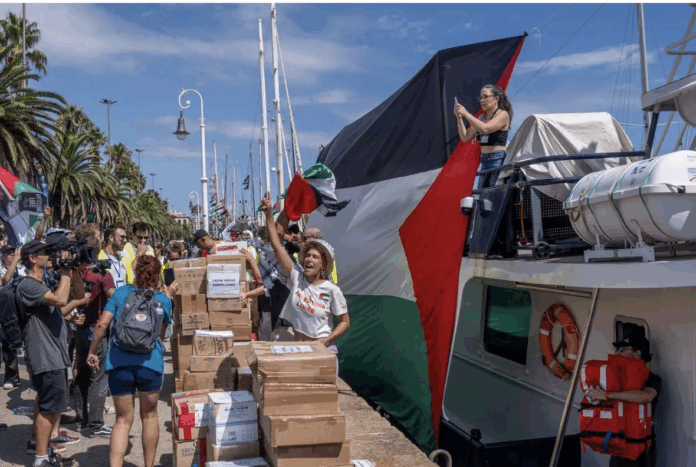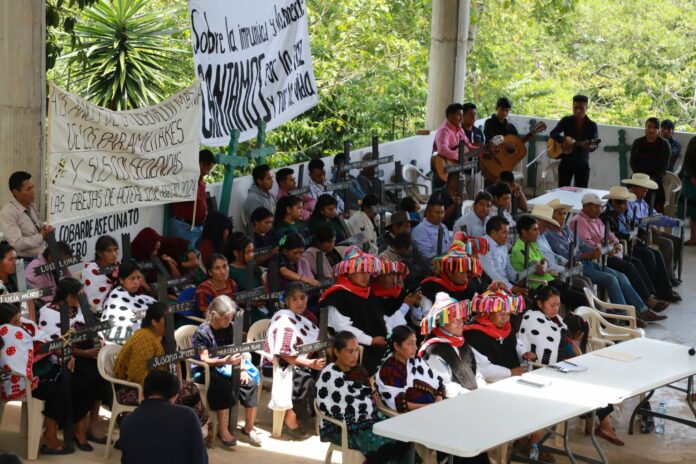In the northern Mexican state of Veracruz—an area considered a priority zone for fracking by the Mexican government—rural, Nahua, and Tutunaka communities coexist with a landscape scarred by oil spills, while Operadora de Campos DWF(a company that brings together Mexico’s Diavaz group and the Texas-Swiss transnational Weatherford) exploits the region under an oil contract marred by irregularities and dispossession.
Sumud flotilla heads to Gaza “to break the blockade and stop the genocide”
Translation by Freedom News
As the Sumud Flotilla sails through the Mediterranean, Israel’s stance has been swift, threatening to label its crew, from more than 44 countries, as terrorists and to arrest and imprison them. Following these threats, Italian dockworkers in the port of Genoa have warned that if they lose contact with the flotilla for even 20 minutes, they will block the departure of 14,000 containers of merchandise to Israel.
The flotilla of over 50 boats set sail on Sunday (30 August) from Barcelona, carrying trade unionists, doctors, parliamentarians, and activists such as American actress Susan Sarandon and Portuguese actress Sofía Aparicio, as well as Swedish activist Greta Thunberg, who was detained and deported last June while attempting to break the Gaza blockade with the then-called Freedom Flotilla.
Their objective is threefold: to deliver aid directly, to break the media and political isolation of Gaza, and to denounce to the world what they describe as a “genocidal war” and an “illegal siege”. Since October 2023, Israel has killed more than 62,000 Palestinians and injured more than 157,000. Meanwhile, it continues to systematically obstruct the entry of food and humanitarian aid into the enclave.
“It’s unfortunate that we have to do it ourselves; that we have to load ships with humanitarian aid to try to break the blockade and stop the genocide”, said Saif Abukeshek, a spokesperson for the flotilla, who was detained by Egypt last June during the Global March for Gaza. “We’re not just announcing the mission itself, but the building of a global solidarity movement that works with all oppressed peoples”, he explained.
Israeli national security minister Itamar Ben-Gvir warned that activists travelling aboard the flotilla will be subjected to prolonged detention and will be denied privileges. “We will not allow people who support terrorism to live in comfort. They will face the full consequences of their actions”, Ben-Gvir said.
Responding from Genoa, Riccardo Rudino, representative of the Autonomous Committee of Stevedores (CALP), issued an ultimatum in a video warning that if contact with the fleet is lost for even 20 minutes, “we will block Europe”. He also emphatically stated that “not a single nail will come out. We will go on an international strike, block roads, and block schools”.
In Genoa alone, more than 300 tons of humanitarian aid were collected prior to the flotilla’s departure. This cargo was sent to the port of Catania and distributed to Italian ships that will join the humanitarian voyage.
The voyage is planned to last seven to eight days. Strict security and discretion measures have been implemented, mindful of previous experiences with Israeli repression. This year has already seen two bitter precedents: the Madleen, with Thunberg on board, and the Handala, which were intercepted in June and July respectively by drone attacks and boarded by Israeli commandos in international waters. Their passengers were beaten, kidnapped, deported, and had their phones confiscated.
Despite the drone overflights of the vessels near the coasts of Mallorca and Menorca, which the Flotilla has reported, they continue on their way to Gaza. The vessels advance each day toward their destination, with actions in different countries taking place at all times, ranging from words of encouragement to the addition of more vessels and people.
United States-Mexico-Canada Agreement Sides with U.S. in GM Corn Dispute Without Evidence That It Is Not Harmful to Health
Translation by Schools for Chiapas
The panel established under the Mexico-U.S.-Canada Free Trade Agreement (T-MEC) ruled on December 20 in favor of the United States, finding that elements of Mexico’s presidential decree, signed by then-President Andrés Manuel López Obrador in 2023, banning glyphosate and genetically modified corn cannot be enforced “because they are not based on adequate risk assessment, scientific evidence, and relevant international standards.”
The dispute panel was requested by the United States after Mexico banned the importation of genetically modified (GM) corn. The Mexican government said it did not share the panel’s findings, but will respect them.
The national campaign Sin Maíz, No Hay País (No Corn, No Country or Without Corn, There is No Country) argues that the trade panel has neither the legitimacy nor the capacity to evaluate the measures adopted by a country, aimed at protecting the health of its population, preserving its biocultural wealth and safeguarding the genetic reservoir of a crop that, due to its production volume and diversity of uses, is the most important in the world.
According to the Secretariat of Agriculture and Rural Development, Mexico has 64 corn breeds, 59 of which can be considered native. In 2021, production of the grain was more than 27 million tons and it is so important that it is grown in all 32 states of the country.
“Therefore, under no circumstances can a trade agreement be above Mexico’s sovereignty,” say the networks, organizations and individuals that make up the national campaign.
To ensure and strengthen Mexico’s position, they mention the importance of raising to constitutional status the ban on the planting of genetically modified corn and its consumption as a staple food.
In this regard, a few weeks ago, President Claudia Sheinbaum highlighted in her conference that in order to protect the grain, the presidential decree can be elevated to constitutional status. The initiative was presented in the reform package presented at the beginning of 2024 by López Obrador, a few months before leaving office.
The reform to Articles 4 and 27 focuses, among other issues, on declaring Mexico a country free of genetically modified (GM) corn for planting and human consumption, and for the recognition of corn as a staple food and element of national identity, without commercial interference.
The initiative refers to the modification of the third paragraph of article 4 of the Constitution, which declares corn to be an element of national identity, free of transgenic genetic modifications; while the fifth paragraph establishes the State’s obligation to ensure the conservation and sustainable management of national biodiversity.
Section XX of Article 27 establishes the State’s obligation to promote the conditions for integral rural development and to guarantee the “optimal use of land free of genetically modified corn crops and seeds.”
In August of this year, the initiative was approved by the Chamber of Deputies and was sent to the Board of Directors for its constitutional implications. The legislators’ official website mentions that as of the decree, the entry into the country of genetically modified corn must only be allowed in the form of broken corn, or fragmented grains, so that it lacks the capacity to germinate, unless there is a health risk assessment that takes into account the practices of consumption, diversification, safeguarding, commercialization, industrialization and distribution that may be caused by mixing with corn free of this technology.
On the other hand, in the final report on the dispute, in response to the panel’s question as to whether the 2023 decree could be modified, Mexico responded that it is extremely difficult to answer in the absence of specific findings and reasoning.
Mexico recalled in the case of the disputed claims that, if it were forced to modify the 2023 decree, “it would be withdrawing measures considered necessary to comply with Mexico’s legal obligations to indigenous peoples.” In this case the panel had no comments.
Controversies
With the establishment of the panel, the process began in 2023, in which both countries submitted written arguments to issue a resolution on December 14. But the ruling occurred six days later, on December 20.
The panel was comprised of Christian Häberli, from Switzerland, chairman of the panel, as well as panelists Hugo Perezcano Díaz, from Mexico, and Jean E. Kalicki, from the United States. In addition, experts in international trade and legal aspects related to trade processes.
Sin Maíz No Hay País points out that they are not scientists, nor specialists in public or environmental health. Their work is limited to resolving the administrative dispute filed by the United States against Mexico, without considering the possible impacts of genetically modified corn on the country’s health, biodiversity or environment.
In a context of 30 years Mexico has documented the effects of the use of biotechnology on food and crop biodiversity. The Mexican government presented the panel with a compilation of scientific and peer-reviewed articles.
The United States presented research financed by the industry itself and even publicity pamphlets, which do not prove that genetically modified corn is harmless for the Mexican population.

For the national campaign Sin Maíz No Hay País, for nine years the agribusiness has had the possibility of carrying out all the scientific studies to evaluate the health and environmental effects of planting GM corn in Mexico, under judicial supervision and that of the plaintiff community, but “to date it has refused to carry out any study in Mexico.”
“The Mexican government offered to the U.S. to carry out a joint risk assessment that would cover the needs of both populations, which the U.S. refused to do because it considered it unnecessary. [The panel’s decision] demonstrates the risks that basic foodstuffs are part of trade agreements and are considered as a commodity and not as a priority good for humanity,” emphasizes a communiqué from the national campaign.
The U.S. representation also reiterated that Mexico’s presidential decree hinders free trade, but according to the organizations, the argument is unfounded, since corn imports have grown in recent years, concentrating mainly on grain for animal consumption, based on official import figures.
“It is essential that we continue to demand that the Mexican government maintain its firm stance against GM corn in the face of transnational interests. This debate has highlighted deficiencies in the international systems for evaluating genetically modified organisms and their risks to human and environmental health,” he emphasizes. The panel also failed to evaluate the implications on corn diversity, which is fundamental to fight against the consequences of climate change.
The Root
Mexico is the center of origin, domestication and diversity of corn, and has the largest gene pool in the world, according to the National Council of Humanities, Sciences and Technologies (Conahcyt), the result of breeding by peasants over the last 10,000 years.
During the administration of Andrés Manuel López Obrador, two presidential decrees were issued prohibiting the importation of genetically modified (GM) corn for agricultural crops, in order to avoid risks to the biodiversity of native corn and human health.
In the first decree, published in 2020 in the Official Gazette of the Federation (DOF), a general restriction on genetically modified corn was proposed, but the provision lacked clarity.
By February 2023, a new decree was published to replace the previous one, which, in addition to banning this corn for human consumption, provides for gradual substitution and specifies, for example, that genetically modified corn can no longer be imported, that no permits for planting will be granted, that this corn must not be present in the food of the Mexican population (in the dough and tortilla industry) and that gradually this corn must not be present in the livestock industry and other industrial food uses either.
Based on the fact that the US export of corn to Mexico is a 5 billion dollar business, that is to say, it is enormous, highlights Tania Monserrat Tellez of Sin Maíz No Hay País, “then the US, in order to pressure Mexico, and for us to remove those provisions, began to activate some articles of the Trade Agreement.”
Following the publication of the decree in the Federal Official Journal (Federal Official Journal)in August 2023, the United States requested a dispute resolution panel with Mexico on agricultural biotechnology, specifically genetically modified corn, and invoked Article 31 of the T-MEC.
Article 31 establishes that when a country considers that another country is not complying with the agreement, technical consultations can be held, which allows the US to question Mexico regarding the regulations it has adopted.
“Since the beginning of the Free Trade Agreement (NAFTA), there have been very critical voices in Mexican society regarding the inclusion of basic grains, including corn since 1994. Now, this is precisely the result of this handover of our country, of the market, of our food since the signing of the agreement,” laments Tellez.

“It should be clarified that what is being questioned in the panel is not whether GMOs are harmful or not, what is being questioned in the panel is a procedural issue of whether Mexico complied with the process established in the T-MEC to establish a provision such as the decree,” she explains.
Civil society from Mexico, the United States and Canada participated in the panel and spoke out against U.S. pressure on Mexico through the T-MEC. The Mexican organizations sought to broaden the discussion within the panel with more input.
They contributed in the form of Technical Opinions, which means that any non-governmental entity can request the panel to send a technical opinion and, in general terms, the opinions issued by the Mexican and US organizations were accepted and some were rejected.
“Those of Canada were rejected because it is an interested third country and they argued that they were not part of the controversy,” explains the representative of Sin Maíz No Hay País. But, of all the civil society arguments, only one was not in favor of Mexico.
In March 2024, written opinions were formally presented to the panel and, in them, the organizations sought to incorporate different elements such as the impact on the great diversity of corn in Mexico as a center of origin and diversification of the crop; the impacts on the biocultural heritage, the right to health and to appeal to a precautionary measure in the absence of evidence on the industries involved in its creation and distribution.
But the dispute panel process continued without the formal participation of the organizations because there is no other mechanism provided within the panel for society to participate. “What we did was to organize a campaign to disseminate what was happening in the panel, mainly in social networks,” says Tellez.
Among other actions, they called for the signing of a letter sent to the panelists inviting them to resolve in favor of the health of Mexicans, cultural heritage and environmental and cultural rights, in the context of a face-to-face session between the countries and the panelists held in Mexico City.
In this context, the results of the disclosure campaign were also presented, as well as the 125,000 signatures gathered against genetically modified corn.
After the negative ruling against Mexico, Tellez points out that there is no way for civil society organizations to appeal. “We believe that the panel is a procedure that responds to a structure that is made for free trade to win without taking into account the damages it can cause, in this case the rights affected by the arrival of GM corn in our country,” she says.
U.S. Cannot Prove Safety of Corn
“The (U.S.) companies have had the opportunity to make requests to plant transgenic corn, but they have not done so because they do not want to comply with the procedure to demonstrate the harmlessness of those corns. So, in all these years and outside the framework of the lawsuit, neither the U.S. industry nor the government has developed any evidence to demonstrate that corn is safe for the population. We consume eleven times more corn than in the U.S.,” Téllez reports.
She points out that they have also not demonstrated the innocuousness in terms of the environment, such that they have not applied for permits to plant, “they could do so in the framework of the lawsuit”, but, in fact, they do not want to be submitted to those tests, “so there is no evidence.”
“We question: why should the buyer have to prove that a product that someone is selling is harmful? It is absurd, under no circumstances does a consumer prove to the seller that what he is going to buy is not harmful. The United States should prove it and has not done so.”
The national campaign Sin Maíz No Hay País appeals to the precautionary principle, as it is a legal concept in which, when there is doubt about the existence of damage from the mentioned technologies, precautionary measures must be taken, “and that is what Mexico is doing.”
In the dispute panel, the Mexican government supported its defense with the arguments of Conahcyt, Semarnat, Cofepris. The Secretariat of Economy maintained a legal team that carried out the defense.
Proven Contamination
According to the Agricultural Markets Consulting Group (GCMA), from January to November 2023, more than 18 million tons of genetically modified corn entered Mexico. Although the export of this grain has a very long history, since the 90’s with NAFTA there was a major growth in imports.
In 2001, the first reports on the presence of transgenes from genetically modified organisms (GMOs) in native grains from the Sierra de Oaxaca were presented. The National Council of Humanities, Sciences and Technologies (Conahcyt) conducted a molecular analysis of 5,304 samples of native corn in Mexico from 2000 to 2023.
This is part of the Evaluation of the Presence of Genetically Modified Sequences in Mexico’s Native Corn, which also highlights that from 2009 to 2023, the percentage of presence of transgenes at the national level increased from 1% to 33%.
Regarding the 5,304 samples analyzed, Conahcyt showed that 12%, that is, 644 presented genetically modified sequences. Most of them are concentrated in eight of the 32 states of the country, that is, 26% of the territory.
The southern region of the country presents a larger amount of data and studies, mainly in the states of Oaxaca and Chiapas, although Mexico City and Puebla are the territories where the highest values of GM sequence presence were found, 35% and 27% respectively.
“It was observed that after the release of genetically modified corn in the country (2005 to 2012) there was a notable increase in the presence of transgenes in the states of Jalisco, Michoacán, Oaxaca, Puebla and Sinaloa,” the study states.
Through these results, the Council urged the need to develop short-term strategies to mitigate the spread of transgenes in native corn; it proposed the dissemination of the environmental problem and how it affects Mexico’s gene pool and producers.
It also talked about the design and implementation of biosafety strategies for the protection of native maize, in accordance with traditional agricultural knowledge, beliefs and biculturality for each of the regions of the country. These arguments were presented in the panel as part of Mexico’s strategy in the disputes with the United States.
Tzeltal Political Prisoners File Appeal for their Immediate Freedom

Cover image: Family members of the five prisoners from San Juan Cancuc protest in front of the Palace of Justice of San Cristóbal de Las Casas, Chiapas. May 2023. Photo: Orsetta Bellani
Family members, human rights defenders and organizations, as well as the legal representatives of the five Tzeltal political prisoners from the municipality of San Juan Cancuc, in the highlands of Chiapas, announced that they have filed an appeal to annul the conviction that has maintained the five from Cancuc in prison for more than two years and four months.
Accused of the killing of a municipal policeman in 2022, the five Tzeltales, as well as organizations that are accompanying them, demand their immediate freedom because there is no evidence to maintain them in prison.
The Indigenous Tzeltales are Agustín Pérez Domínguez, Agustín Pérez Velasco, Juan Velasco Aguilar, Martín Pérez Domínguez and Manuel Sántiz Cruz. Although they were first sentenced to 25 years in prison, through an appeal, the courts in Chiapas reduced the sentence to 18 years. However, the demand from their legal team is their immediate freedom.
In a press conference on Thursday August 22, the lawyer Adrián Reyes explained that the appeal was presented at the federal level at the beginning of August—a legal resource contesting the convictions and demanding that the case be thrown out—to achieve the immediate freedom of the five Tzeltal political prisoners.
Reyes explained that the appeal is currently notifying the third parties, among them the Public Prosecutor’s Office of Chiapas, so that they can give their opinion on the legal resource presented on August 6.
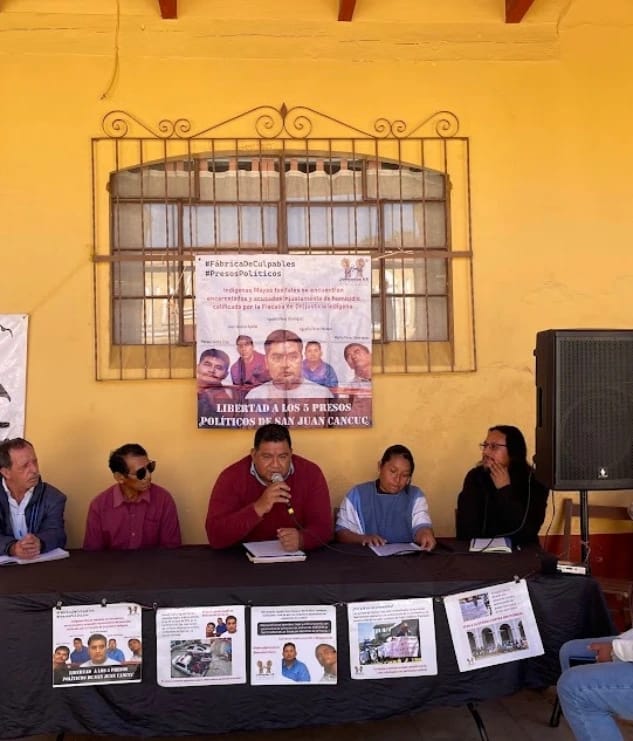
Press conference announcing the filing of the appeal seeking immediate freedom for the five Tzeltal human rights defenders.
“It will be the federal level—in reference to the Collegiate Court of the Superior Tribunal of Justice—who must resolve and analyze each one of the arguments presented in the appeal. It will also have to review that the investigations and each one of the elements of the convictions, which in our opinion are not sufficient to demonstrate the responsibility of those detained,” explained the lawyer in a press conference held in San Cristóbal de las Casas.
Reyes emphasized that the punishment isn’t only imprisonment for the five Tzeltales, but also the hardships of their families in their struggle for justice, as well as the risk to the physical well-being of the prisoners, who in recent months have denounced a series of abuses inside CERSS No. 5, where they are imprisoned.
For the lawyer, the use of the federal appeal is justified because of the actions of judicial power in Chiapas. He points out that since the beginning of the case, the public prosecutor’s office assumed the guilt of the accused, for which an adequate investigation wasn’t carried out to truly demonstrate their participation in the crime, nor did it provide necessary elements to convict them.
According to Reyes, there is great mistrust in the state institutions because they are incorrectly convicting and “they have fabricated a series of crimes that far from leading to justice, violate those most in need.”
Criminalization of Human Rights Defenders
In the press conference were human rights defenders from the Parish of San Juan Cancuc, as well as Petrona Hernández Pérez, wife of Agustín Pérez Domínguez, who read a communique signed by the political prisoners where they highlighted that the crime for which they are accused has been fabricated by the Chiapas Indigenous Justice Public Prosecutor’s Office.
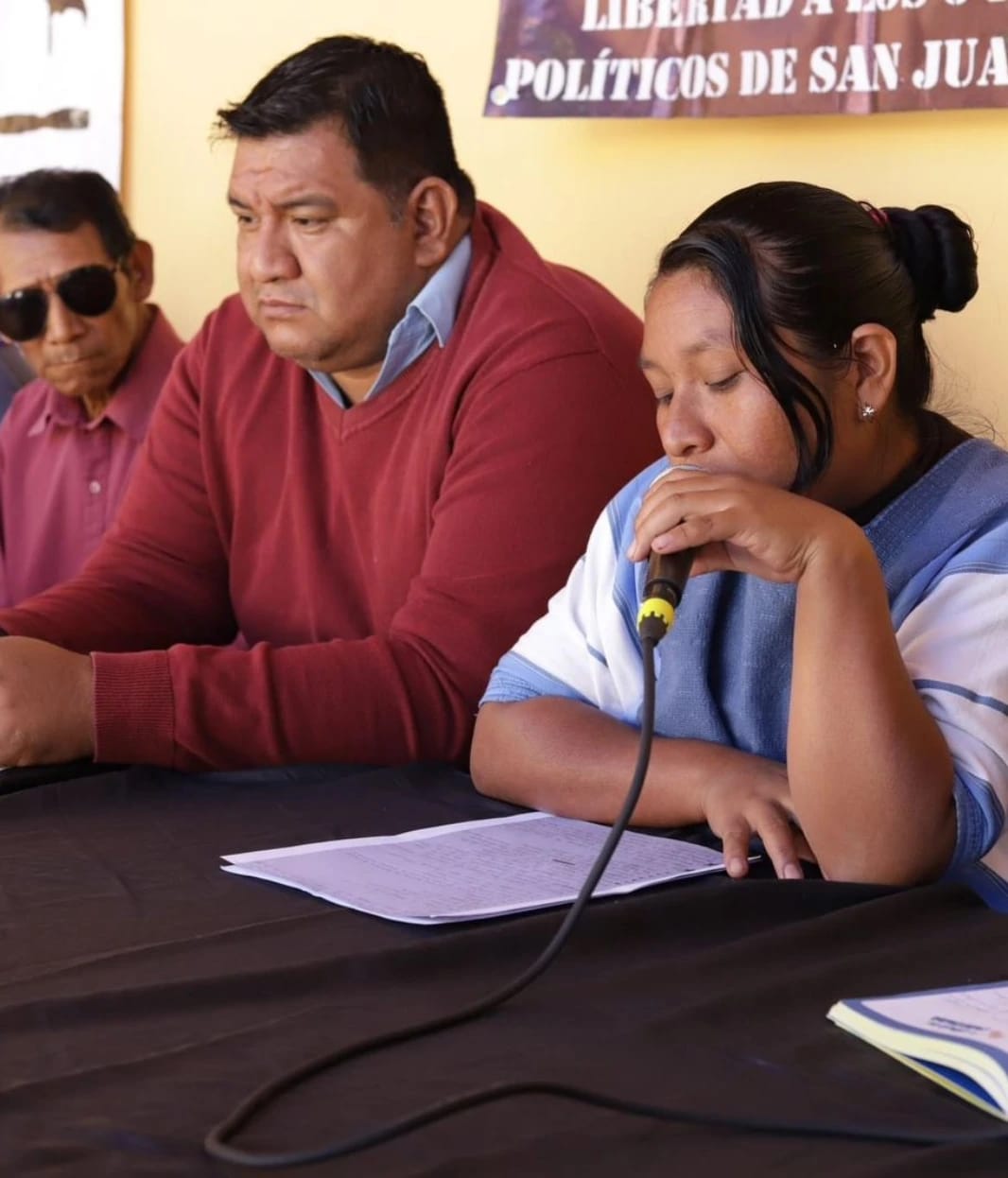
Press conference announcing the filing of the appeal seeking immediate freedom for the five Tzeltal human rights defenders.
“They fabricated crimes against them for defending the land,” said the human rights defenders. They also explained that among the different projects that threaten the Tzeltal communities in the Highlands of Chiapas is the highway project, Carretera de las Culturas, which has been promoted for a decade by the state government and currently seeks to connect the coast of Chiapas with the Maya Train in Palenque.
“That is why they were incarcerated. As defenders, they want to threaten us, imprison us. We are defenders of land and territory,” sustained the Tzeltal human rights defenders.
The Parish Priest of San Juan Cancuc, José Luis Vargas, who has accompanied the actions for freedom of the five political prisoners, assured that “the prisons are full of innocent people due to this corrupt system that we have in Mexico and that there is no justice.” He also indicated that they will keep up the struggle together with the families and organizations to free the Indigenous Tzeltales.
Already Failed Dam Project Being Revived in Oaxaca to Address Water Crisis
Cover image: A resident of San Juan Chapultepec, Oaxaca, showing the water they receive from the tap. Photo: Santiago Navarro F
The rains that have covered the central valleys of Oaxaca in southern Mexico during the last two months have temporarily eased the intense heat, drought, and lack of water suffered in the state. Yet regardless of the temporary relief, “the reality is not like this,” warns Juan José Consejo of the Institute of Environment and Society of Oaxaca (INSO).
Public discussion surrounding the water crisis in Oaxaca was revived in recent weeks after the governor of the state, Salomón Jara, in the presence of the president elect, Dra. Claudia Sheinbaum, announced the proposal to restart construction on the Paso Ancho dam to “endow” water to the metropolitan zone of Oaxaca, which includes 22 municipalities.
Twelve years ago, in 2012, the construction of the dam began in the municipalities of San Vicente Coatlán and Sola de Vega—in the southeast area of the state, in the transition zone between the central valley and the sierra madre mountains—with then governor Gabino Cué. In 2014, the construction was suspended by the Federal Attorney for Environmental Protection (PROFEPA) for not having authorization to change the soil use designation in forested lands.
In addition to PROFEPA, the Secretariat of Environment and Natural Resources (SEMARNAT) decided to discard the authorization linked to 1.0251 hectares because “it didn’t present the technical information and legal documentation.” At that moment, this action was taken up against the company in charge of the project, Tradeco Infraestructura, S.A. de C.V. The authorities documented that already 2.0174 hectares of low deciduous and oak forest vegetation had already been affected.
This project was taken up anew in January 2024, in the Congress of Oaxaca, where the engineer Nezahualcóyotl Salvatierra López, Secretary of Infrastructures, detailed the project as “strategic” because according to the government, “it could be the long term solution to the problem of lack of water in the metropolitan zone (of Oaxaca).”
For Consejo, a crisis as complex as this one cannot be resolved by a project or a decree although politicians tend to think so. “It requires a very well elaborated set of measures of legal, technical, administrative, and economic character. We sometimes refer to these failed projects that they try to revive as the return of the zombies. These are already dead things that they want to see walk again,” he says.
The organizations which participate in the Observatory demand that information about the project be made public and that the right of the communities to be informed and consulted be respected. “There is no information of where it will be located, how many municipalities the aqueduct has to cross (around 90km), and what it implies for these municipalities. In addition, we do not know what will happen with the communities that are downstream from the dam because the water will be retained by the project,” says Mauricio del Villar Zamacona of the Oaxacan Water Forum.
“We need information about the project,” says Consejo, but there are elements that are characteristic of these types of projects that “we continue to see as insurmountable.” For example, these are projects that are very expensive and usually have a short life span in relation to their costs, “no more than 20-25 years, then they become useless.”
Inequality Worsens the Crisis
The possible revival of the project is taking place in a national context where different social movements are fighting “above all against the role played by the National Water Commission in promoting these types of projects, whose viability is in question,” says Nadir Hernández, of the organization Flor y Canto. “Above all because they continue generating patterns of inequality in access to water. That is to say, water continues to be provided to businesses and urban centers, and those who continue suffering the dispossession of water in their own territories are Indigenous communities and towns. They benefit the least from these types of projects.”
Another demand is the revision of the system of water concessions. It is a system that is designed to dispossess the communities of their water. It grants large concession holders, major companies, and certain individuals, access and free use of ground water. This has generated unequal distribution,” adds Hernández.
Other Options Exist
Politicians typically use the argument that “there is no other option. We must bring water in from somewhere else,” says Consejo ironically, to justify the large projects. “I would like to emphasize that, yes, there is another option, or there are multiple other options. In reality, for a long time a series of measures have been proposed to adequately address the problem of water; measures that are cheaper and, on many occasions, quicker than this project. Without a doubt they make more sense from a social and ecological point of view,” he explains.
He explains some of them: preserve the water catchment zones that still exist in the central valleys; activate projects and programs to harvest water; repair the public water pipes; assure that the water is cleaned and that polluting it is prohibited; establish systems for saving and recycling water. “What I want to emphasize is that, yes, we have concrete proposals to present in a discussion that must be public and open in order to address the problem that affects us all.”
Where is it?
Villar Zamacona explains that the Observatory had access to the makeup of the 2024 budget designated to water “There is an important budget for water-related issues. Around 8 billion pesos. We do not know exactly where that money is being used.”
He also states that at the end of February, there was a conference held by the state government, where they said that by the beginning of 2025, the Paso Ancho project should begin.
Social Organizations Warn of a New Surge in Violence in the Highlands of Chiapas
Cover image: Press conference from Las Abejas de Acteal to mark the 15th anniversary of the release of the paramilitaries involved in the 1997 massacre.
The forced displacement of Indigenous communities—a consequence of the crisis of violence in Chiapas—has not stopped. In recent weeks there has been an increase in families who have been forced to abandon their homes in the municipalities of the highlands of Chiapas.
On August 4th, 200 community members from San José El Carmen, in the municipality of Pantelhó, abandoned their homes due to violence caused by clashes between armed groups. Days before, nearly 200 people fled from the community of La Esperanza in the neighboring municipality of San Pedro Chenalhó. In that same municipality, 100 people fled the Tsostil community of Tzanembolom, on July 20th.
On Monday, August 12th, local media reported that residents of both municipalities were still reporting gunfire from high caliber weaponry. “The inhabitants have remained inside their homes. It has been months since they have been able to work their fields or collect firewood because of the fear of being assassinated.,” said one of the people interviewed.
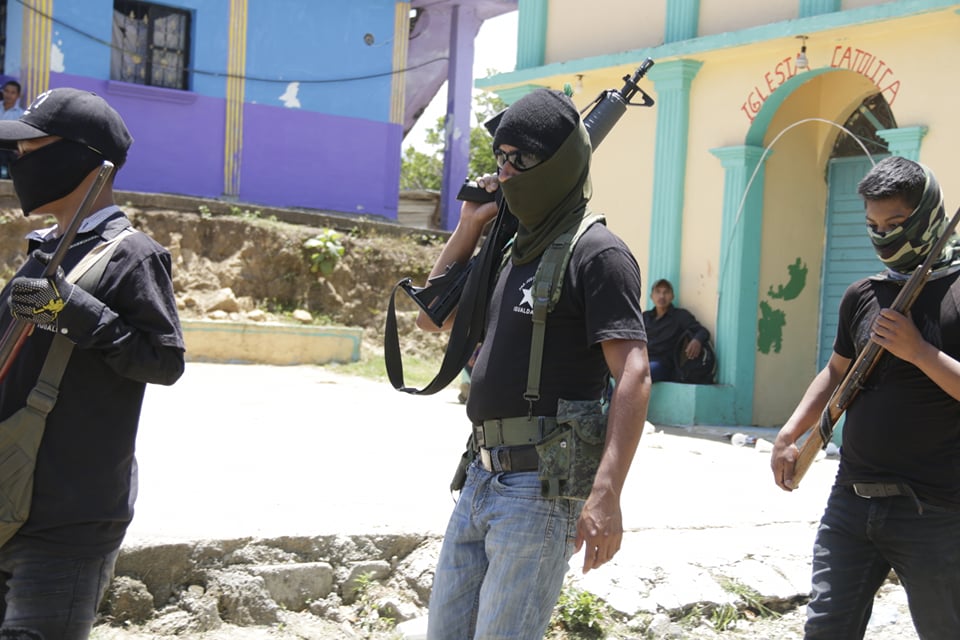

Members of the self-defense group, El Machete. Photos: Somos el Medio
According to testimony from inhabitants, clashes continue near Tzanembolóm, where they say one of the armed groups was carrying out forced recruitment, a motive for which the people fled their communities.
On Monday August 12th, the organization Las Abejas de Acteal, who have continued struggling for justice after the massacre in their community in 1997, warned that the violence in the Chiapas highlands “is already unstoppable.” During a press conference in San Pedro Chenalhó, members of Las Abejas pointed out that the situation of violence in the region is similar to that which they experienced in days prior to the massacre perpetrated at the end of the 1990’s.

While the press conference was part of the demand for justice on the 15th anniversary of the release of the perpetrators of the massacre in Acteal, the conference was also used to denounce the current situation of violence.
“It gives us great sadness, our hearts cry for the violence that is already unstoppable, and that has converted into a monster devouring everyone in its path. For example, in the area where we live, in the municipality of Pantelhó, and the communities of Chenalhó near Pantelhó, we have been forcibly displaced due to constant gunfire from armed groups. As is already known, the Mexican military and national guard allow these acts to occur right beneath their noses,” they explained in a statement.
Due to the surge in violence in the region, Las Abejas reactivated the Civil Campaign for Peace, a refuge constructed in the community of Nueva Yibeljoj in October 2020 to house families displaced by paramilitaries in 1997.
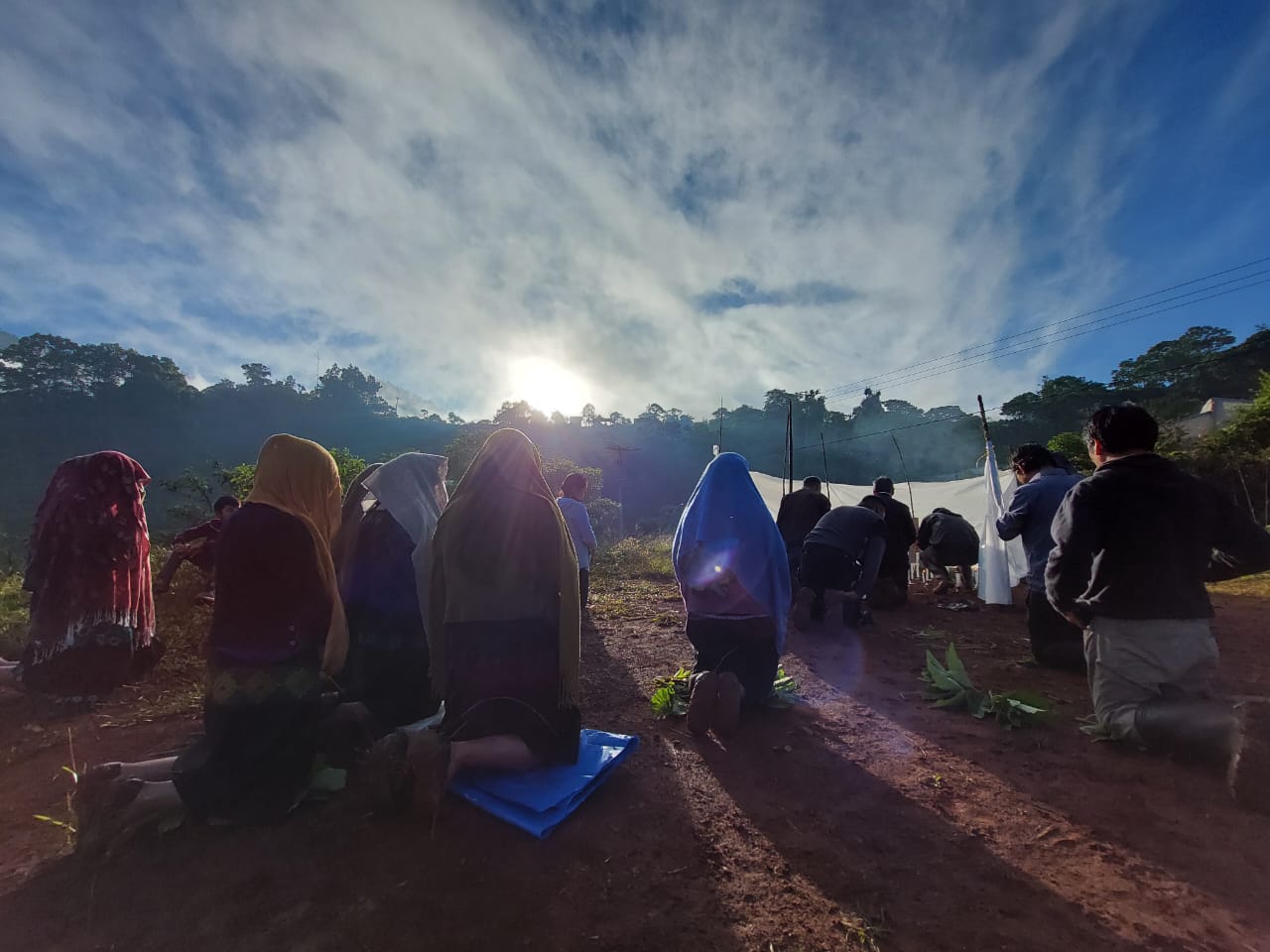
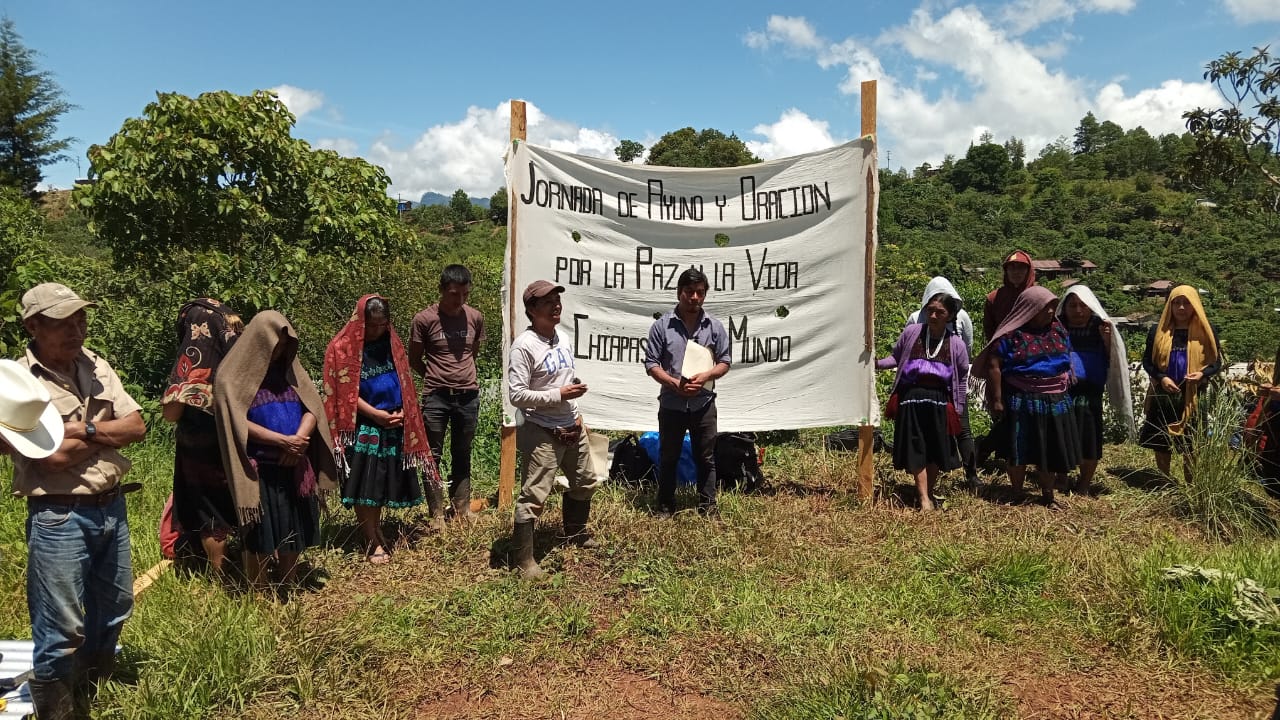
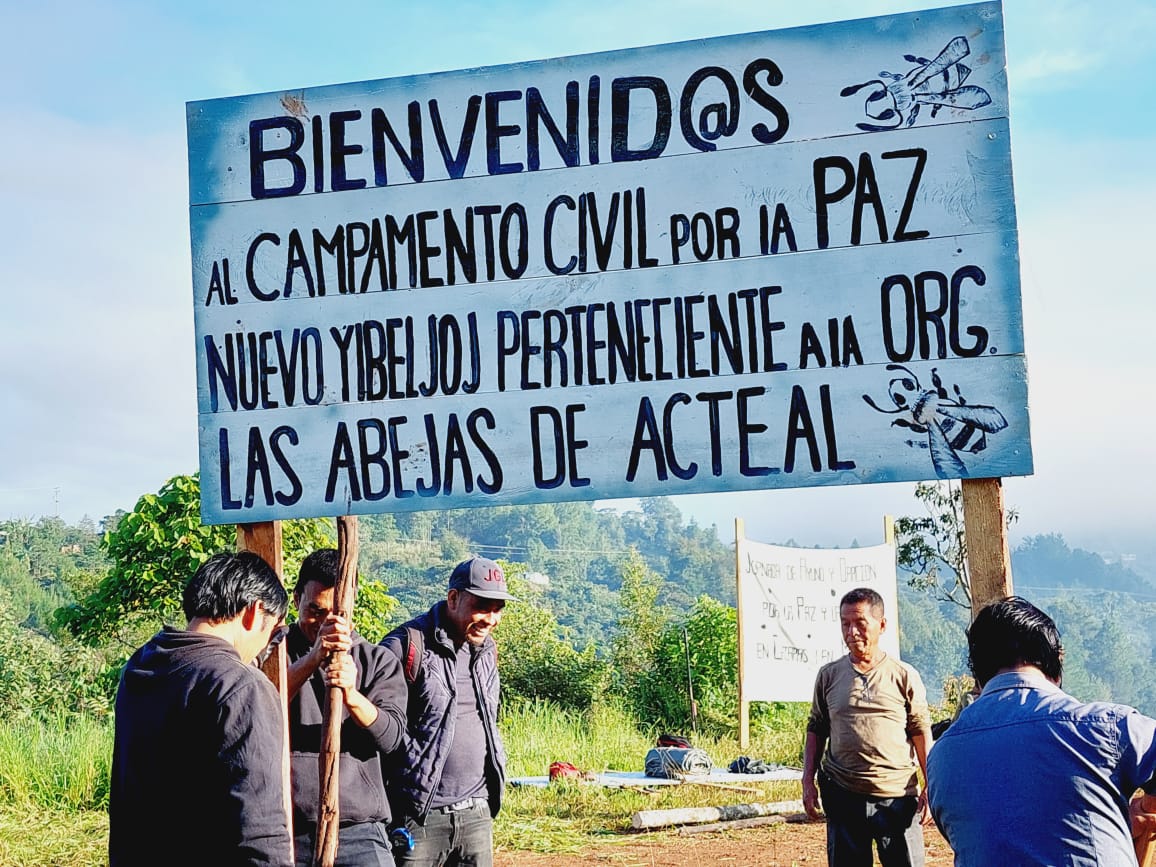
During the ceremony on August 6th, members of Las Abejas relaunched their work at the refuge with fasting and prayer. They also announced the reactivation of the camp allowing them to maintain the memory and hope alive. “With this action we seek to send a message to the three levels of government that they attend to our demands for justice and peace.,” they said.
Rising Violence
For Las Abejas, the violence is increasing causing fear and pain with the memory of the 1997 massacre. “We could say that we are reliving what we already lived through,” says Guadalupe Vázquez Luna, a survivor of the massacre.
They denounced that the release of the perpetrators of the 1997 massacre was the consequence of a campaign launched in 2006 involving the Centro de Investigaciones y Docencias Económicas (CIDE), Confraternice, Hugo Eric Flores Cervantes, Héctor Aguilar Camín, Manuel Anzaldo Meneses, and the then president of Mexico, Felipe Calderon Hinojosa.
“The impunity, which is the fruit of their collaboration, has led Chiapas to a civil war, just as the Zapatista Army of National Liberation warned in one of their communiques last year,” they explained.
In the face of this situation, the Indigenous Tsotsiles assured that, instead of guaranteeing that what happened in Acteal doesn’t happen again, impunity allows the organized crime groups to maintain the population terrorized, “encouraging the forgetting of the Massacre of Acteal, as well as those of Ayotzinapa, Tlatlaya, Pasta de Conchos, Aguas Blancas, and other crimes committed by the state throughout the country,” they denounced in the statement.
Postponed Elections
It should be noted that the municipality of Pantelhó is one of the three localities in which extraordinary elections are planned for August 25th. This is due to the fact that during the election on June 2nd, conditions of violence didn’t allow the installation of voting booths in the municipality of Los Altos, nor in the municipality of Chicomuselo, in the border region. In the third municipality, Capitán Luis Ángel Vidal, the State Electoral Tribunal invalidated the election for irregularities such as the burning of voting booths.
In this context, inhabitants of the municipality of Pantelhó have sent messages via social media to warn of the increase in violence in recent days, for which they argue the conditions won’t allow a secure election.



